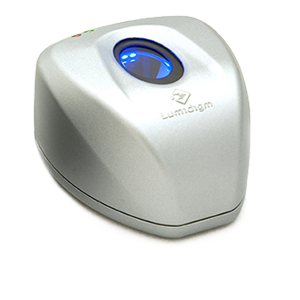Lumidigm V-Series Fingerprint Sensors
Overview
Lumidigm V-Series fingerprint sensors deliver industry-leading biometric performance regardless of environmental or skin conditions. You can depend on the V-Series to return superior images on anyone, anytime, in any environment.
Lumidigm V-Series fingerprint sensors outperform other sensors by improving your application’s throughput, accuracy, speed, and security. Let Lumidigm’s patented technology solve your management hassles and users’ frustration by delivering the high-quality images you expect…every time.
Image is Everything
Lumidigm’s multispectral imaging technology simultaneously reads the surface and subsurface to capture clear, clean images every time—even when surface features are absent or hard to distinguish due to age, dirt, finger pressure, and skin or environmental conditions. Our sensors enroll and verify every fingerprint including those that thwart conventional sensors. Solve failure to enroll (FTE) and failure to acquire (FTA) issues with Lumidigm’s V-Series fingerprint sensors.
Superior Liveness Detection
Eliminate performance problems associated with conventional fingerprint sensors. Lumidigm V-Series sensors protect against fake and spoof fingerprints by capturing detailed surface and subsurface data from the fingertip. Using the biometric industry’s best liveness detection technology, we provide the most secure and accurate sensors available—over 20,000 samples tested and detected to date.
Patented multispectral imaging is the most secure, convenient and reliable fingerprint authentication technology on the market today. Only available in Lumidigm® products and solutions, multispectral imaging can enroll and verify everyone, every time, in any environmental condition.
Lumidigm® multispectral imaging is a sophisticated technology specifically developed to overcome the fingerprint capture problems found with conventional imaging systems. This more-effective technology is based on the use of multiple spectrums of light and advanced optical techniques to extract unique fingerprint characteristics from both the surface and subsurface of the skin. That subsurface capability is important because the fingerprint ridges seen on the surface of the finger have their foundation beneath the surface of the skin, in the capillary beds and other sub-dermal structures.
This enhanced data capture mitigates traditional system vulnerabilities to common environmental and demographic conditions:
- Dry conditions — Dry fingertips are common, caused by anything from climate conditions or natural skin characteristics to frequent hand-washing or air travel. Multispectral imaging technology captures high-quality images even when fingers are dry.
- Wet conditions — Moisture is a fairly common real world condition. Some environments are naturally damp, due to climate (London) or setting (a spa). Some people have moist hands. Multispectral imaging technology captures high-quality images even in wet conditions.
- Diverse demographics — Biometrics work because people are unique — and yet diverse user populations are difficult for many fingerprint biometrics systems to handle. Multispectral imaging can authenticate anyone, no matter what their age, ethnicity, job or lifestyle.
- Rugged conditions— People don’t have time to wash and lotion their hands when they use a fingerprint sensor. And yet other technologies require just that to meet performance requirements. Multispectral sensors take people as they are — at the office, construction site, or agricultural field.
With multispectral imaging, these problems are solved. In major large-scale programs, pilot tests, field trials and evaluations, Lumidigm® multispectral imaging technology has proven to be the best technology in the biometrics industry.
Liveness Detection
A variety of materials and methods, from the inexpensive to the very sophisticated, can be used to circumvent traditional fingerprint identification systems. Called “spoofs”, some of these fake fingerprints are so thin and colorless that they can even be used, undetected, in access control environments that have trained attendants.
Lumidigm® V-Series sensors and modules have patent-protected liveness detection capability that looks beyond the surface of the skin and can discriminate between the features of live skin and copies of fingerprint features in a fraction of a second. Multispectral imaging goes beyond conventional, contact-oriented measurements to deliver not only superior real world biometric performance but the best liveness detection capability in the industry. It provides protection from published and unpublished methods of producing and using finger copies that will defeat conventional fingerprint sensors.
Lumidigm’s liveness detection is built from cutting-edge machine learning algorithms and can be updated as new spoofs are identified. Unlike any other fingerprint technology, this “learning” capability allows Lumidigm fingerprint sensors to keep up with new threats.
It is important to note that all the published literature on making finger copies and testing spoof protection is based on copies that are made with a cooperative subject. While collecting a latent print from an uncooperative subject is certainly possible, creating a copy of such a print that is of a high enough quality to match the subject’s print and defeat liveness detection is very difficult.




